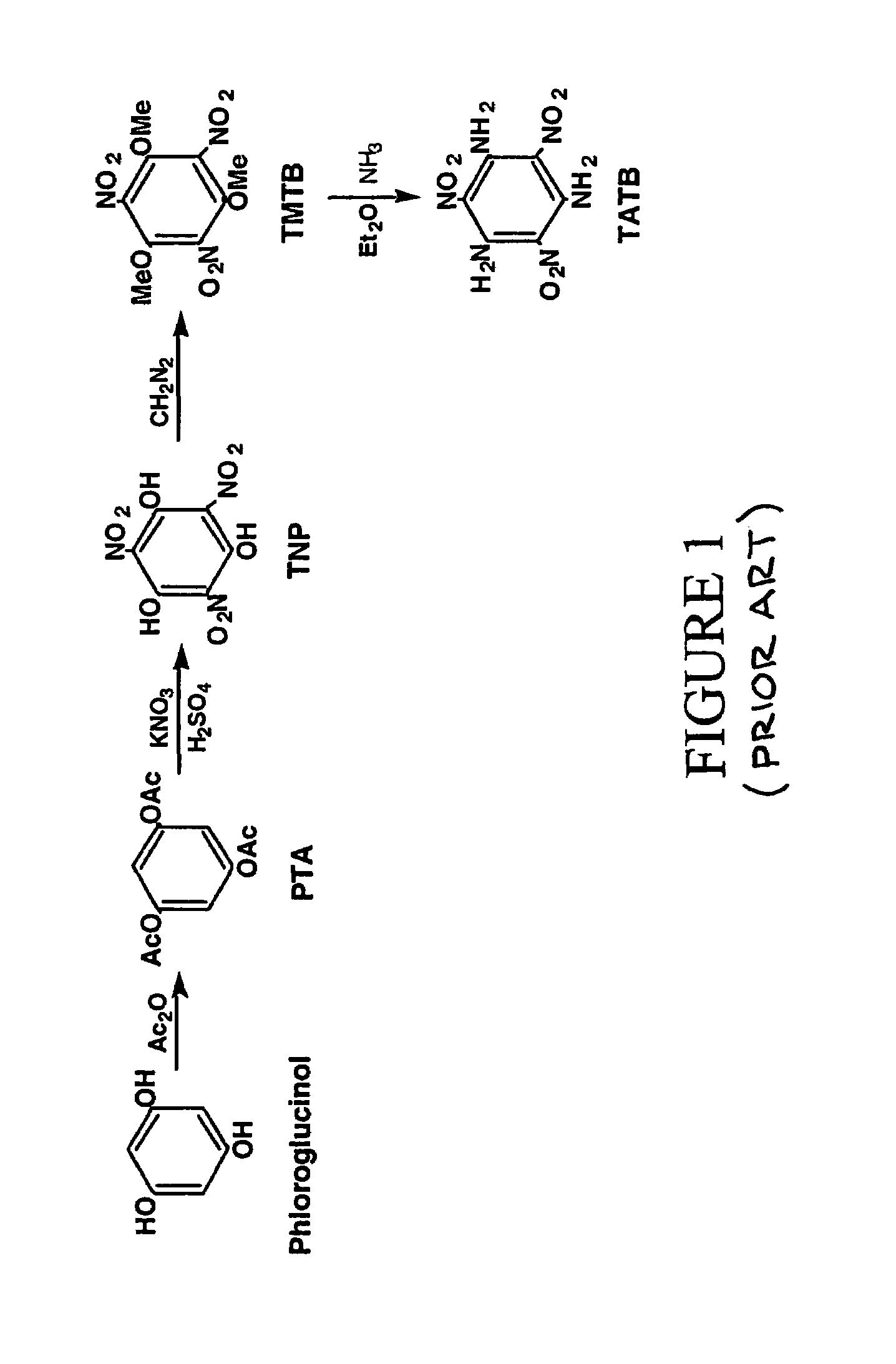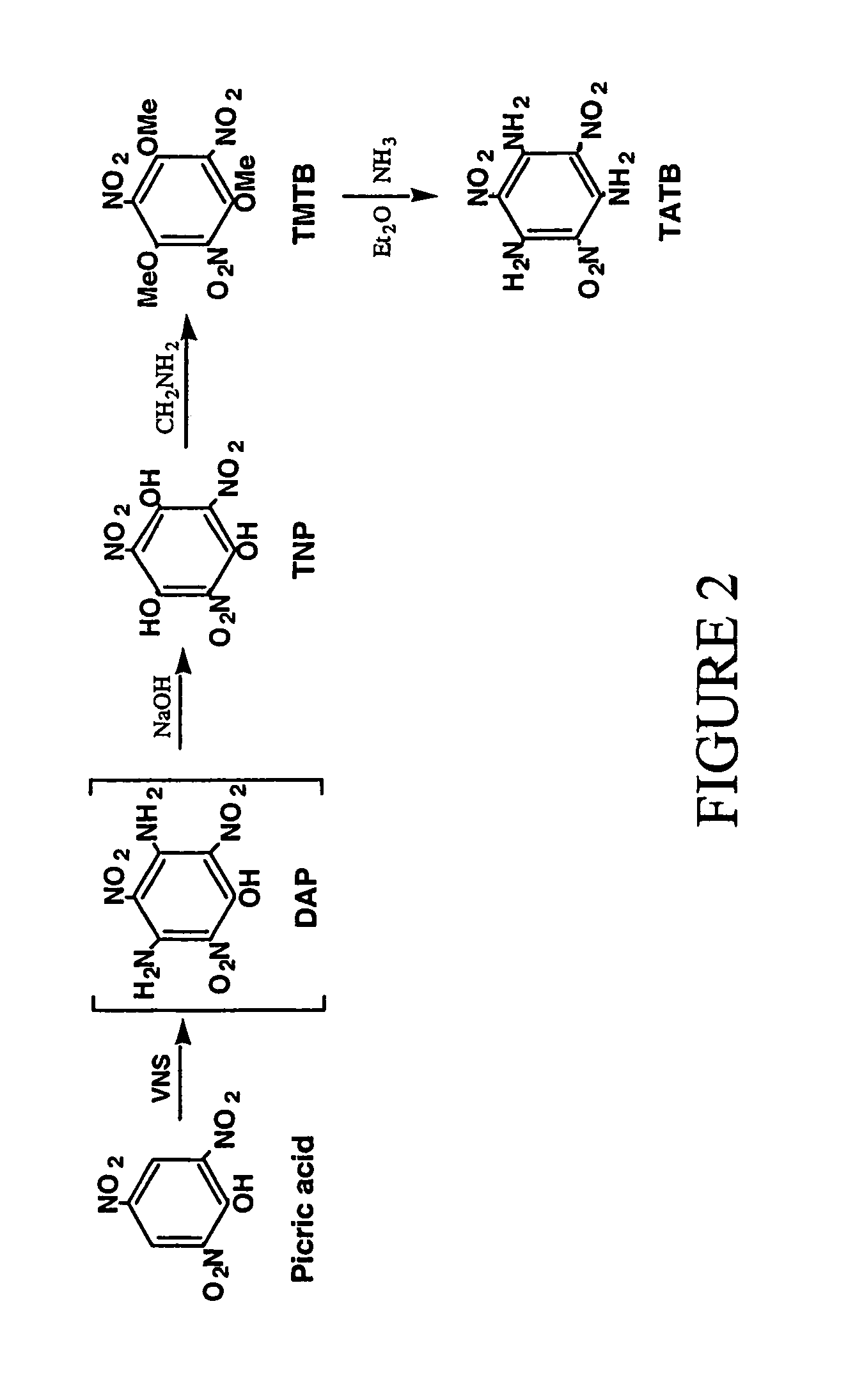Synthesis of trinitrophloroglucinol and triaminotrinitrobenzene (TATB)
a technology of triaminotrinitrobenzene and trinitrophloroglucinol, which is applied in the preparation of amino compounds, organic chemistry, chemistry apparatus and processes, etc., can solve the problem of inacceptable ob/od of these materials
- Summary
- Abstract
- Description
- Claims
- Application Information
AI Technical Summary
Benefits of technology
Problems solved by technology
Method used
Image
Examples
example 1
[0017](a) Picric acid (0.275 g, 1.20 mmol) and 4-amino-1,2,4-triazole (0.504 g, 6.00 mmol) are dissolved in a mixture of DMSO (3.6 ml) and toluene (4.8 ml) and a 25 wt. % solution of sodium methoxide in methanol (3.00 ml, 13.1 mmol) is added. The resulting suspension produced a lemon-yellow suspension is stirred and heated from ambient temperature to 95° C. over a one hour period. The suspension is cooled to 4° C., treated with glacial acetic acid (14 ml) and warmed to ambient temperature with stirring. The resulting precipitate is collected and washed with acetic acid and water. Vacuum drying (80° C.) gives 0.176 g of diaminopicric acid. An additional 0.034 g of product is isolated from the acetic acid-water washes to give a total of 0.210 g of diaminopicric acid (68% yield). The IR spectra for this material and known diaminopicric acid (W. M. Koppes, et al, “Reaction of 1,3,5-trifluorotrinitrobenzene with nucleophiles,” Journal of the Chemical Society-Perkin Transactions 1, 1815, ...
example 2
[0019]Diaminopicric acid (0.100 g, 0.386 mmol) is suspended in water (6.85 ml) and a 50% aqueous solution of sodium hydroxide (0.65 ml,12.5 mmol) is added. The suspension is stirred for 0.5 hr in a heated water bath (98–100° C.) to produce an orange-red suspension which is cooled to 4° C. Addition of cold 12N hydrochloric acid (4 ml) produces a deep yellow suspension that is heated to solution. Cooling to 4° C. produces orange-yellow crystals (needles) that are collected, washed with cold 3N hydrochloric acid and dried to give trinitrophloroglucinol (0.085 g) in 84% yield. The IR spectrum for this material corresponds to that for known trinitrophloroglucinol.
example 3
[0020]Picric acid (0.27 g, 1.20 mmol) and 4-amino-1,2,4-triazole (0.504 g, 6.00 mmol) are dissolved in a mixture of DMSO (3.6 ml) and toluene (4.8 ml) and treated with a 25 wt. % solution of sodium methoxide in methanol (3.00 ml, 13.1 mmol). The resulting suspension is stirred and heated from ambient temperature to 95° C. over a one hour period. The reaction suspension is cooled to ambient temperature prior to the addition of water (22.5 mL) and a 50% aqueous solution of sodium hydroxide (1.95 ml, 37.2 mmol). The brick-red suspension is stirred for 0.5 hour in a heated water bath (98–100° C.) and cooled in an ice bath for several hours. The resulting suspension is filtered and the resulting orange solid (trinitrophloroglucinol sodium salt) is collected and dissolved in hot 3N hydrochloric acid (16 ml). The resulting solution is cooled to ambient temperature prior to storage at 4° C. The crystalline product is collected, washed with cold 3N hydrochloric acid and dried to give trinitr...
PUM
| Property | Measurement | Unit |
|---|---|---|
| temperature | aaaaa | aaaaa |
| temperature | aaaaa | aaaaa |
| temperature | aaaaa | aaaaa |
Abstract
Description
Claims
Application Information
 Login to View More
Login to View More - R&D
- Intellectual Property
- Life Sciences
- Materials
- Tech Scout
- Unparalleled Data Quality
- Higher Quality Content
- 60% Fewer Hallucinations
Browse by: Latest US Patents, China's latest patents, Technical Efficacy Thesaurus, Application Domain, Technology Topic, Popular Technical Reports.
© 2025 PatSnap. All rights reserved.Legal|Privacy policy|Modern Slavery Act Transparency Statement|Sitemap|About US| Contact US: help@patsnap.com



